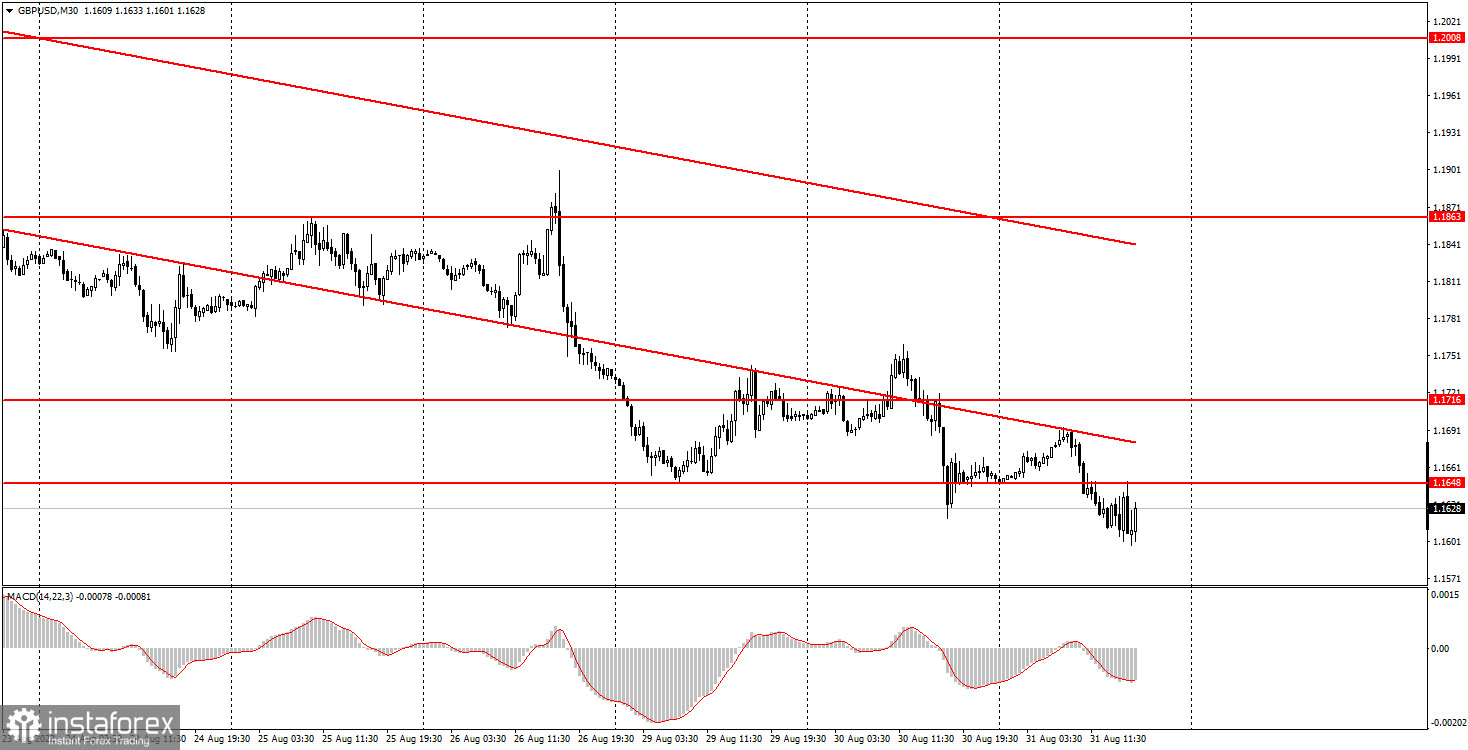Analysis of Wednesday's deals:
30M chart of the GBP/USD pair

The GBP/USD pair, unlike EUR/USD, continued its downward movement on Wednesday. However, the movement is not as good as it might seem at first glance. Its disadvantage is that the pair has been updating its lows by 20-30 points for the last two days, and correcting for the rest of the day. Thus, we do not get one-way traffic during the day. The pair is still below the descending channel, so the presence of a downward trend does not raise any questions. The moment raises questions, due to which the pound is now falling, if the euro is in a flat at the same time? From our point of view, this is a rather strange moment. Nevertheless, there are global reasons for the British currency's fall, so in general the pair's movement is not surprising. The UK did not release any important reports, meanwhile, the US published a report from ADP on the number of new jobs in the private sector (similar to NonFarm Payrolls). Its value is 132,000, which is lower than forecasts. We cannot say that the market reacted violently to this report, but the dollar's growth could stop because of it. However, in this case it will be renewed. A much more powerful NonFarm Payrolls report will be released at the end of the week, which will show the true state of things in the US labor market.
5M chart of the GBP/USD pair

The pound/dollar pair did not show the best movements on the 5-minute timeframe. If the European trading session can still be called a trend movement, then the US one started a pure flat around 2-year lows. Take note that the level of 1.1620 is Tuesday's low, and the level of 1.1601 is Wednesday's low, which did not take part in today's trading at all. If the sell signal near the level of 1.1648 could still be worked out (it was clearly not possible to earn much on it), then songs and dances began around the level of 1.1620. This is exactly what we talked about above. When the lows are updated, the pair goes below them only by a couple of tens of points, after which corrections begin that interfere with work. As a result, a short position should have been closed when consolidating above the level of 1.1620, and it was possible to earn a high of a couple of points on it. All subsequent signals should not have been worked out, since in the first two hours near the level of 1.1620 it became clear that there would be no strong signals.
How to trade on Thursday:
The pound/dollar pair continues to follow a downward trend on the 30-minute TF. The level of 1.1648 was easily overcome, which increases the likelihood of further decline. There are enough reasons for the fall now, even technical ones, but at the same time the movement itself is not the best. On the 5-minute TF on Thursday, it is recommended to trade at the levels 1.1601, 1.1620, 1.1648, 1.1716, 1.1755, 1.1793, 1.1863-1.1877, 1.1967. When the price passes after opening a deal in the right direction for 20 points, Stop Loss should be set to breakeven. Nothing interesting is planned for Thursday in the UK either. We recommend paying attention to the ISM business activity index in America, which can cause a market reaction and is a more important index than the S&P.
Basic rules of the trading system:
1) The signal strength is calculated by the time it took to form the signal (bounce or overcome the level). The less time it took, the stronger the signal.
2) If two or more deals were opened near a certain level based on false signals (which did not trigger Take Profit or the nearest target level), then all subsequent signals from this level should be ignored.
3) In a flat, any pair can form a lot of false signals or not form them at all. But in any case, at the first signs of a flat, it is better to stop trading.
4) Trade deals are opened in the time period between the beginning of the European session and until the middle of the US one, when all deals must be closed manually.
5) On the 30-minute TF, using signals from the MACD indicator, you can trade only if there is good volatility and a trend, which is confirmed by a trend line or a trend channel.
6) If two levels are located too close to each other (from 5 to 15 points), then they should be considered as an area of support or resistance.
On the chart:
Support and Resistance Levels are the Levels that serve as targets when buying or selling the pair. You can place Take Profit near these levels.
Red lines are the channels or trend lines that display the current trend and show in which direction it is better to trade now.
The MACD indicator (14,22,3) consists of a histogram and a signal line. When they cross, this is a signal to enter the market. It is recommended to use this indicator in combination with trend lines (channels and trend lines).
Important speeches and reports (always contained in the news calendar) can greatly influence the movement of a currency pair. Therefore, during their exit, it is recommended to trade as carefully as possible or exit the market in order to avoid a sharp price reversal against the previous movement.
Beginners on Forex should remember that not every single trade has to be profitable. The development of a clear strategy and money management are the key to success in trading over a long period of time.





















